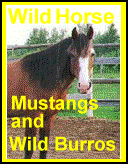U.S. Congress, December 1971
Mustang

Mustang

The term "Mustang" derives from the Spanish mestena, which means a group or a herd of horses, and is applied to the "wild" horses of western America. The Mustangs were the mounts of Indian and white man alike. The Mustang was also the foundation for a large number of the American breeds. It retained many of the Spanish characteristics, especially in respect of color.
When the Spanish conquistadores landed on the American continent, the horse had been extinct on the continent for some 10,000 years. The Spanish introduced both horses and cattle to the New World. These cattle were the foundation stock for the great cattle industry that was to develop extensively during the nineteenth century.

At the beginning of the twentieth century, an estimated one million wild horses roamed the western states. By 1970, their numbers had been drastically reduced as a result of wholesale massacre to supply pet food and meat for human consumption. The Mustang is now protected by laws and preserved by bodies like the Wild Horse Research Center at Porterville, California.
The Mustang has the classic Spanish profile, the thick, crested neck and the luxurious growth of mane that is typical of the modern Andalusian. The old sort of Mustang was often much less attractive and many were heavy in the head. The outline of this horse and his whole appearance is entirely Spanish. The impression is of strength combined with balance and athleticism. The mustang has a good, strong foreleg and a powerful shoulder. The withers are not prominent but are typical of the old Spanish stock. The Mustang's legs and hooves, unprotected by shoeing, are hard and enduring and the horses are able to travel over the roughest terrain without their hooves becoming unsound. The dorsal eel-stripe is a primitive marking still found on horses of Spanish origin. The Mustang can come in all equine colors and stands between 13.2-15hh.
Reference: The Ultimate Horse Book; Elwyn Hartley Edwards; 1991
Wild Horses of the Pryor Mountains
BLM's National Wild Horse & Burro Page
KBR's World of Wild Horses & Burros
Wild Mustang Gallery
Reference Photo courtesy of Pryor Mountain Mustangs

 This
Wild Horse, Mustang and Wild Burro Web Ring site is owned by
This
Wild Horse, Mustang and Wild Burro Web Ring site is owned by White Arabian. Want to joing the Wild Horse, Mustang and Wild Burro Web Ring? |
|---|
| [Skip Prev] [Prev] [Next] [Skip Next] [Random] [Next 5] [List Sites] |
